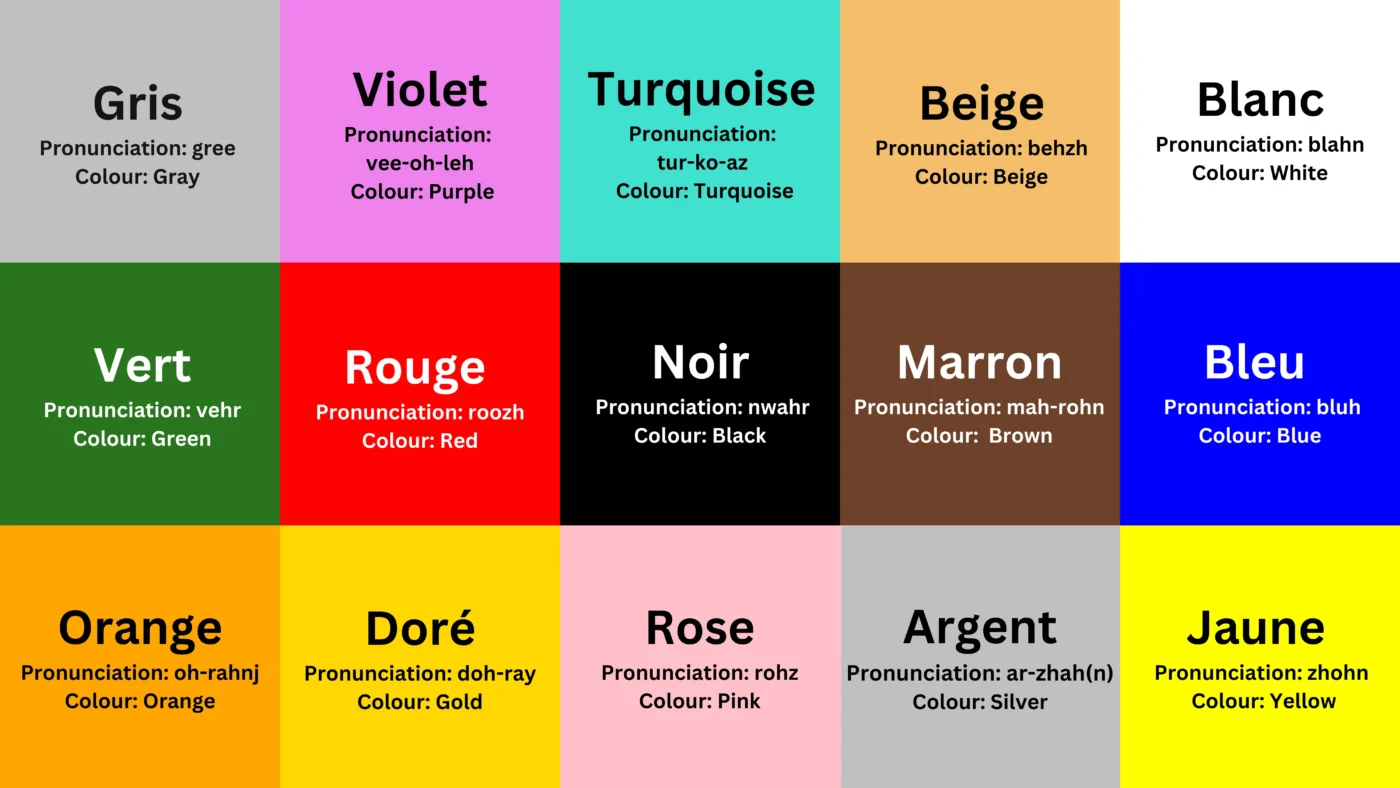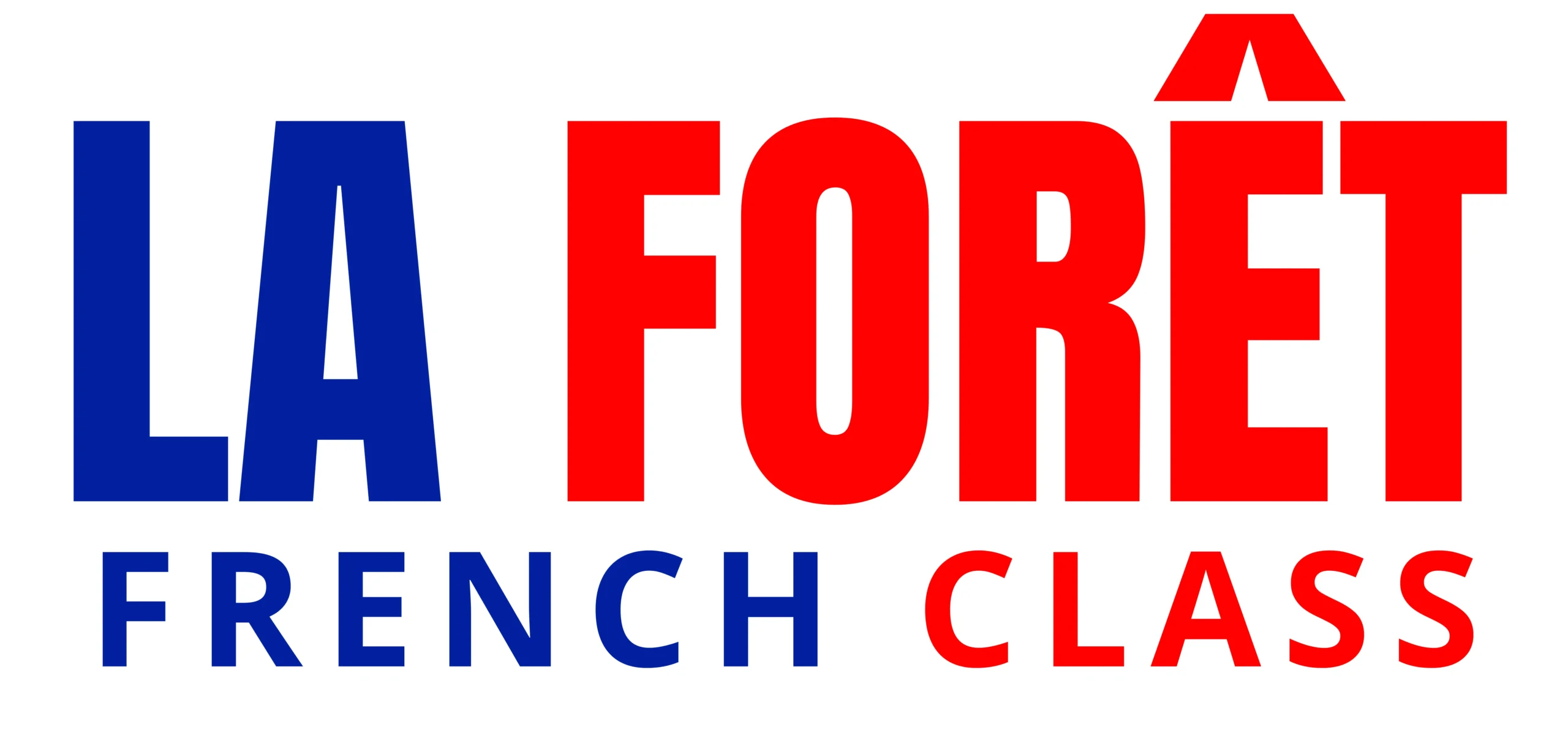Colour is a fundamental aspect of human perception, communication, and expression. In the context of language learning, understanding colours in French goes beyond vocabulary; it is a gateway to cultural nuances, artistic appreciation, and descriptive fluency. Mastering colours in French enhances communication skills, enables accurate descriptions, and deepens understanding of French culture and expressions.
Colours in French


Grammatical Use of French Colours
1. Agreement with Nouns: In French, colour adjectives agree in gender and number with the nouns they describe.
Masculine singular nouns take the masculine form of the colour adjective.
- Example: Un livre rouge (a red book).
Feminine singular nouns take the feminine form of the colour adjective.
- Example: une voiture rouge (a red car).
Plural nouns, regardless of gender, take the plural form of the colour adjective.
- Example: Des fleurs rouges (red flowers).
- Example: Des chaises rouges (red chairs).
2. Irregular Colours: Some colour adjectives have irregular forms:
- Masculine and Feminine: Orange (orange), Beige (beige), Mauve (mauve), Pourpre (purple) and Marron (brown) do not change based on gender.
- Example: un stylo orange (an orange pen).
- Example: Une jupe orange (an orange skirt).
- Example: Un mur beige (a beige wall).
- Example: une robe beige (a beige dress).
3. Positioning with Nouns: Colour adjectives generally follow the noun they describe but can come before it in specific cases for emphasis or stylistic reasons.
- Example with colour after the noun: Une robe bleue (A blue dress).
- Example with colour before the noun: Un beau bleu ciel ciel (A beautiful blue sky).
4. Using “de” for certain colours: When referring to colours as characteristics rather than direct descriptions, use “de” before the colour.
- Example: Un chien de couleur noir (a dog of black colour).
- Example: Des yeux de couleur bleue (Eyes of blue colour).
5. Compound Nouns with Colours: In compound nouns, the colour often comes after the last noun.
- Example: Un tapis vert foncé (a dark green carpet).
- Example: Une voiture rouge vif (a bright red car).
By following these rules, you can use French colours correctly with masculine and feminine forms and ensure agreement with nouns in different contexts.
| No. | French Colour (Mas.) | French Colour (Fem.) | French Colour (Mas. Pl.) | French Colour (Fem. Pl.) | English Meaning |
|---|---|---|---|---|---|
| 1 | Noir | Noire | Noirs | Noires | Black |
| 2 | Argent | Argent | Argent | Argent | Silver |
| 3 | Or | Or | Or | Or | Gold |
| 4 | Bleu | Bleue | Bleus | Bleues | Blue |
| 5 | Ciel | Ciel | Ciel | Ciel | Sky blue |
| 6 | Citron | Citron | Citron | Citron | Lemon |
| 7 | Mauve | Mauve | Mauves | Mauves | Mauve |
| 8 | Bordeaux | Bordeaux | Bordeaux | Bordeaux | Burgundy |
| 9 | Rose | Rose | Roses | Roses | Pink |
| 10 | Marine | Marine | Marine | Marine | Navy blue |
| 11 | Saumon | Saumon | Saumon | Saumon | Salmon |
| 12 | Rouge | Rouge | Rouges | Rouges | Red |
| 13 | Marron | Marron | Marron | Marron | Brown |
| 14 | Jaune | Jaune | Jaunes | Jaunes | Yellow |
| 15 | Turquoise | Turquoise | Turquoise | Turquoise | Turquoise |
| 16 | Gris | Grise | Gris | Grises | Gray |
| 17 | Violet | Violette | Violets | Violettes | Purple |
| 18 | Orange | Orange | Orange | Orange | Orange |
| 19 | Blanc | Blanche | Blancs | Blanches | White |
| 20 | Vert | Verte | Verts | Vertes | Green |
| 21 | Beige | Beige | Beige | Beige | Beige |
| 22 | Lavande | Lavande | Lavande | Lavande | Lavender |
| 23 | Pêche | Pêche | Pêche | Pêche | Peach |
| 24 | Pourpre | Pourpre | Pourpre | Pourpre | Purple/Deep Red |
| 25 | Ivoire | Ivoire | Ivoire | Ivoire | Ivory |
Understanding the months of the year in French can enhance your vocabulary and language skills.
French Hair Colour Vocabulary
In French, colours are often used to describe hair, just like in English. Here is some common French hair colour vocabulary and how it is used:
1. Blond (Blonde): This can refer to light-coloured hair, ranging from platinum blond (blond platine) to darker shades like ash blonde (blond cendré).
2. Brun (Brunette): Describes brown hair, which can vary from light brown (châtain clair) to dark brown (brun foncé).
3. Roux (Red/Auburn): Used for red or auburn hair. For example, “des cheveux roux” means red hair.
4. Noir (black) refers to black hair, which can be either natural or dyed.
5. Châtain (Chestnut/Brown): This is used for hair that is a shade of brown, typically ranging from medium to dark brown.
French Colour-Related Verbs
- Rougir (to redden): used when something becomes red, often due to embarrassment, anger, or blushing.
Example: Elle a rougi en entendant le compliment. (She reddened upon hearing the compliment.)
- Jaunir (to yellow) refers to something turning yellow, like paper ageing or leaves changing colour.
Example: Les feuilles jaunissent en automne. (The leaves are yellow in autumn.)
- Verdir (to become green): used when something takes on a green colour, such as plants growing or metals oxidizing.
Example: La pelouse a verdi après la pluie. (The lawn turned green after the rain.)
- Bleuir (to become blue): indicates something becoming blue, like bruises on the skin.
Example: Son visage a bleui à cause du froid. (His face became blue due to the cold.)
- Griser (to become grey) refers to something turning grey, like hair or walls, due to ageing or exposure.
Example: Les cheveux grisaient avec l’âge. (The hair was graying with age.)
- Noircir (to blacken) is used when something becomes black, often due to burning or staining.
Example: La fumée a noirci le plafond. (The smoke blackened the ceiling.)
- Blanchir (to whiten) refers to something becoming white like clothes being bleached or teeth whitening.
Example: Il a blanchi le linge avec de l’eau de javel. (He whitened the laundry with bleach.)
- Brunir (to brown): indicates something becoming brown, like food cooking or skin tanning.
Example: Le pain brunissait dans le four. (The bread was browning in the oven.)
- Grisonner (to become grey or white, typically used for hair): Specifically used for hair turning grey or white with age.
Example: Ses cheveux ont commencé à grisonner dès la quarantaine. (His hair started graying in his forties.)
- Rosir (to pinken) refers to something becoming pink or rosy in colour.
Example: Ses joues ont rosies après l’effort. (Her cheeks pinkened after the exertion.)
Expand your vocabulary with our Body Parts in French guide, detailing essential terms to enhance your language skills.
Expressions with Colours in French
10 expressions in French that use colours along with their meanings:
- Être rouge de colère (to be red with anger) means to be extremely angry or furious.
- Voir la vie en rose (to see life through rose-coloured glasses) means to be optimistic or have a positive outlook.
- Tomber dans les pommes (to fall into the apples) means to faint or lose consciousness.
- Avoir la peur bleue (to have a blue fear) means to be extremely scared or terrified.
- Passer une nuit blanche (to have a white night) means to stay up all night, typically due to insomnia or work.
- Être blanc comme un linge (to be as white as a sheet): meaning to be very pale, often due to fear or shock.
- Mettre les points sur les i’s (to put the dots on the i’s) means to clarify or make something very clear.
- Avoir le moral dans les chaussettes (to have your morale in the socks) means to feel down or have low spirits.
- Passer du vert au rose (to go from green to pink) means to change dramatically or unexpectedly.
- Tre vert de jalousie (to be green with jealousy) means to be highly jealous.
Colour Symbolism in French Culture
Colour symbolism in French culture can vary, often overlapping with broader Western symbolism and having unique associations. Here are ten colours, along with their symbolic meanings in French culture:
- Blanc (white) represents purity, innocence, and sometimes mourning or death.
- Noir (black) symbolizes elegance, formality, mourning, and darkness.
- Rouge (red) signifies passion, love, energy, courage, and sometimes danger.
- Bleu (blue): associated with calmness, tranquillity, depth, trust, and sometimes sadness.
- Vert (green) represents nature, growth, fertility, hope, and jealousy.
- Jaune (yellow) symbolizes joy, happiness, optimism, energy, and sometimes cowardice.
- Rose (pink): Associated with sweetness, romance, tenderness, and femininity.
- Gris (Gray): represents neutrality, balance, practicality, and sometimes gloominess.
- Violet (purple) symbolizes royalty, luxury, spirituality, creativity, and sometimes mystery.
- Or (gold) represents wealth, prosperity, success, and sometimes extravagance.
Conclusion
Understanding the grammatical rules of using colours in French is essential for accurate communication. Colour adjectives must agree with nouns in gender and number, and there are irregular forms for certain colours. Expressions and symbolism using colours offer insights into French culture and language nuances. Learning colours in French grammar enhances language proficiency and deepens cultural understanding and expression. Additionally, La Forêt French Class provides resources or courses related to French language learning.
Learn to count in French effortlessly with our comprehensive guide on French Numbers.
Frequently Asked Questions
Q: What are Parisian colours?
Ans: Paris is often associated with a palette of elegant and timeless colours, including shades of grey, cream, black, and muted pastels like blush pink. These colours reflect Parisian chic and sophistication.
Q: What colour is the French flag?
Ans: The French flag, known as “Le Tricolore,” consists of three vertical stripes of blue, white, and red from left to right. This iconic flag symbolizes liberty, equality, and fraternity.
Q: Which colours are feminine in French?
Ans: In French, colours have masculine and feminine forms. Some feminine colours include rose (pink), violette (purple), jaune (yellow), and bleue (blue).
Q: What colour is French style?
Ans: French style is often characterized by a classic colour palette that includes neutrals like black, white, grey, and navy blue. These colours exude elegance, sophistication, and timeless beauty.





